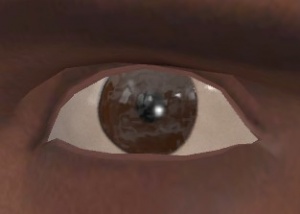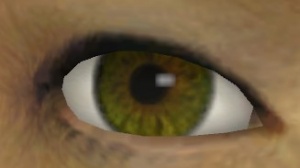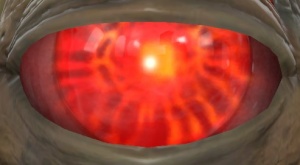Eyeball: Difference between revisions
Jump to navigation
Jump to search

 Tip:The
Tip:The
m (Fix self-redirected links) |
Deprecated (talk | contribs) (Removed information only true for the Eyes shader, added disambiguation template) |
||
| Line 2: | Line 2: | ||
[[Image:Eye alyxep2.jpg|thumb|Alyx's eyeball in [[Episode Two]], using the obsolete [[Eyes]] shader.]] | [[Image:Eye alyxep2.jpg|thumb|Alyx's eyeball in [[Episode Two]], using the obsolete [[Eyes]] shader.]] | ||
[[Image:Eye vortep2.jpg|thumb|A vortigaunt's largest eye. The iris covers its entire surface.]] | [[Image:Eye vortep2.jpg|thumb|A vortigaunt's largest eye. The iris covers its entire surface.]] | ||
{{For|about=the [[QC]] property of [[$model]]|the shaders used to render the eyes|{{ent|EyeRefract}} and {{ent|Eyes}}|the tool|[[qc_eyes]]}} | |||
'''<code>Eyeball</code>''' is a property of [[$model (QC)|$model]]. It | '''<code>Eyeball</code>''' is a property of [[$model (QC)|$model]]. It defines the data needed to properly render a character's eyes, defining the name, positioning, size and material of the eyeball. | ||
== Parameters == | == Parameters == | ||
| Line 21: | Line 16: | ||
: World location of the center of the ball of the eye. While your eye doesn't need to be a sphere in the model, Source will always map the material according to an invisible ball. | : World location of the center of the ball of the eye. While your eye doesn't need to be a sphere in the model, Source will always map the material according to an invisible ball. | ||
;<code><material_name></code> | ;<code><material_name></code> | ||
: Material | : Material of the eye. Make sure each or every eye has a unique one. It is recommended to use a material using the <code>EyeRefract</code> shader. | ||
;<code><diameter></code> | ;<code><diameter></code> | ||
: Width of the eyeball when viewed from the front. Used to prevent the iris from rolling inside the head. {{note|The iris will travel in a circle even if the eyeball is oval. Your model's [[flex]] should accommodate for this. {{todo|How?}} }} | : Width of the eyeball when viewed from the front. Used to prevent the iris from rolling inside the head. {{note|The iris will travel in a circle even if the eyeball is oval. Your model's [[flex]] should accommodate for this. {{todo|How?}} }} | ||
;<code><angle></code> | ;<code><angle></code> | ||
: Default yaw offset (from directly forward) for iris. Humans are typically 2-4 degrees [[Wikipedia:Strabismus|wall-eyed]]. Not setting this correctly will result in either your characters appearing cross-eyed, or if you've compensated by misplacing the ball of the eye, them not tracking side to side. Should be a negative value for the left eye, and a positive value for the right eye. | : Default yaw offset (from directly forward) for the iris. Humans are typically 2-4 degrees [[Wikipedia:Strabismus|wall-eyed]]. Not setting this correctly will result in either your characters appearing cross-eyed, or if you've compensated by misplacing the ball of the eye, them not tracking side to side. Should be a negative value for the left eye, and a positive value for the right eye. | ||
;<code><iris_material></code> | ;<code><iris_material></code> | ||
: Material used as the iris texture. (This property is deprecated) | : Material used as the iris texture. (This property is deprecated) | ||
;<code><iris_scale></code> | ;<code><iris_scale></code> | ||
: Scale of the iris texture. The model's UV map does not influence the eye material in any way. {{todo|While this is true for <code> | : Scale of the iris texture. The model's UV map does not influence the eye material in any way. {{todo|While this is true for <code>EyeRefract</code>, is this also true for the <code>Eyes</code> shader?}} | ||
=== Example === | === Example === | ||
| Line 42: | Line 37: | ||
== See also == | == See also == | ||
* [[Eye Position Setup]], for a guide to calculating the various numbers required | * [[Eye Position Setup]], for a guide to calculating the various numbers required | ||
[[Category:Modeling]] | [[Category:Modeling]] | ||
Revision as of 16:16, 18 February 2020

The Demoman's eyeball, using the EyeRefract shader.
This article is about the QC property of $model. For the shaders used to render the eyes, see EyeRefract and Eyes. For the tool, see qc_eyes.
Eyeball is a property of $model. It defines the data needed to properly render a character's eyes, defining the name, positioning, size and material of the eyeball.
Parameters
qc_eyes tool can help you manage the potentially confusing string of numbers needed for this command.<name>- Name of eyeball, used to match eyelid rules. For humans, use
righteyeandlefteye. <bone_name>- The bone which the eye is parented to, typically the head.
<X> <Y> <Z>- World location of the center of the ball of the eye. While your eye doesn't need to be a sphere in the model, Source will always map the material according to an invisible ball.
<material_name>- Material of the eye. Make sure each or every eye has a unique one. It is recommended to use a material using the
EyeRefractshader. <diameter>- Width of the eyeball when viewed from the front. Used to prevent the iris from rolling inside the head.
 Note:The iris will travel in a circle even if the eyeball is oval. Your model's flex should accommodate for this. Todo: How?
Note:The iris will travel in a circle even if the eyeball is oval. Your model's flex should accommodate for this. Todo: How? <angle>- Default yaw offset (from directly forward) for the iris. Humans are typically 2-4 degrees wall-eyed. Not setting this correctly will result in either your characters appearing cross-eyed, or if you've compensated by misplacing the ball of the eye, them not tracking side to side. Should be a negative value for the left eye, and a positive value for the right eye.
<iris_material>- Material used as the iris texture. (This property is deprecated)
<iris_scale>- Scale of the iris texture. The model's UV map does not influence the eye material in any way. Todo: While this is true for
EyeRefract, is this also true for theEyesshader?
Example
Hover your mouse over each value for its description.
$model "female_01" "female_01_reference_RE.smd" { eyeball righteye ValveBiped.Bip01_Head1 -1.261 -3.702 64.974 eyeball_r 1 4 pupil_r 0.66 }
See also
- Eye Position Setup, for a guide to calculating the various numbers required

